Bluestreak cleaner wrasse is a fascinating fish with a beautiful color morph and a great personality. It is a beta fish that will pick parasites from other fish, never hurting them.
Although they are beneficial for your home aquarium, experts advise not to keep these fish in home aquaria as they are difficult to impossible to care for. So, if you happen to keep Bluestreak cleaner wrasse in your aquarium, you must be an expert aquarist, and it is better to keep them in a public aquarium.
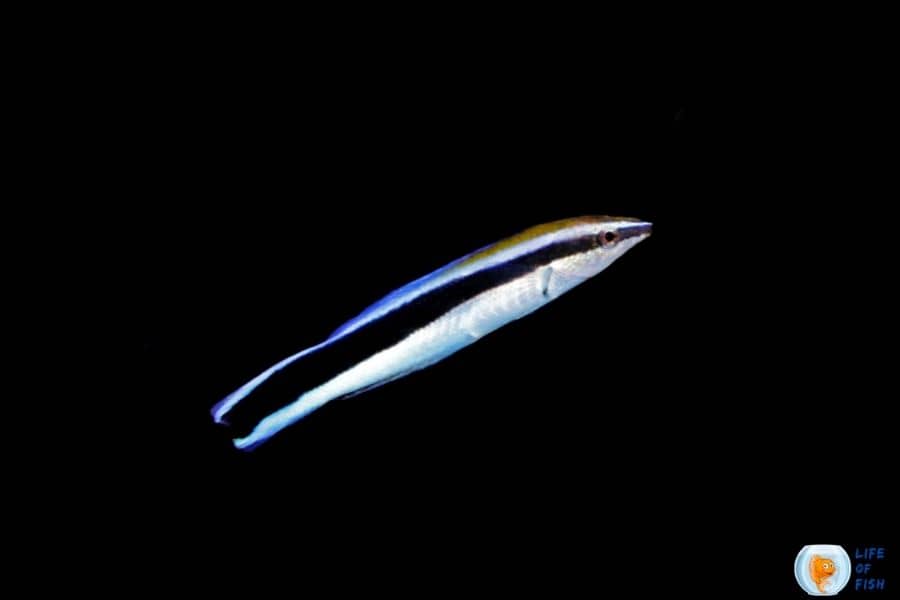
They are popular with aquarists because of their ability to “clean” other fish. It is a good companion for your fish and can live longer in an aquarium if proper care is provided.
Explore the fascinating world of wrasse fish with our in-depth guide – wrasse fish
What is Bluestreak cleaner wrasse?
Jump To
- 1 What is Bluestreak cleaner wrasse?
- 2 Bluestreak cleaner wrasse appearance
- 3 Where should I put my Bluestreak cleaner wrasse?
- 4 How big do they get?
- 5 Are they aggressive?
- 6 Their behavior
- 7 How long do Bluestreak cleaner wrasses live?
- 8 One Look Care Guide
- 9 Bluestreak cleaner wrasse care
- 10 Bluestreak cleaner wrasse breeding
- 11 Special tips
- 12 How to feed Bluestreak cleaner wrasse?
- 13 What fish can live with Bluestreak cleaner wrasse?
- 14 Related questions
- 15 Conclusion
Scientifically named Labroides dimidiatus, Bluestreak cleaner wrasse is a cleaner wrasse species that belongs to the Labroides genus. Cleaner wrasses are famous for their “cleaning ability” of other fishes. They have a symbiotic relationship with the host fishes and provide them with cleaning services while getting food from their hosts.
Cleaner wrasses have a unique behavior where they look for parasites and dead skin from fishes. While cleaning, they gently nibble on the fish’s skin, scales, or fins using their teeth. Bluestreak cleaner wrasse is only one of five species of the Labroides genus, but they are the most popular species among them all.
These fish are known to host a “cleaning station” where they get food by cleaning other fishes. In the wild, other fish species visit these cleaning stations to get “cleaned” by this fish. This exciting fish inhabits shallow coral reefs of the Indian Ocean and Western Pacific, from Eastern Africa to the Red sea and Polynesia.
These are difficult fish to care about but will show you a fun time when being “cleaned” by them. Although they are challenging to keep in an aquarium, experienced aquarists who like challenges can try to keep them.
Bluestreak cleaner wrasse appearance
Bluestreak cleaner fish has a gorgeous color morph. It has a longitudinal black stripe from head to tail on both sides, and the backside and the bottom are white or yellowish. This light part changes to bluish on the back of the fish, and the stripe broadens at the tail side. The juveniles have a black bodies with an electric blue line.
Where should I put my Bluestreak cleaner wrasse?
Bluestack cleaner wrasse is not a good choice for a home aquarium, and it is better to keep them in public aquariums. These fish need a large area of open water in your tank, and they should be kept one or two together in public aquariums.
Although they are known to host a “cleaning station” in the wild, they will not host a “cleaning station” in-home aquaria, as it is not natural to them.
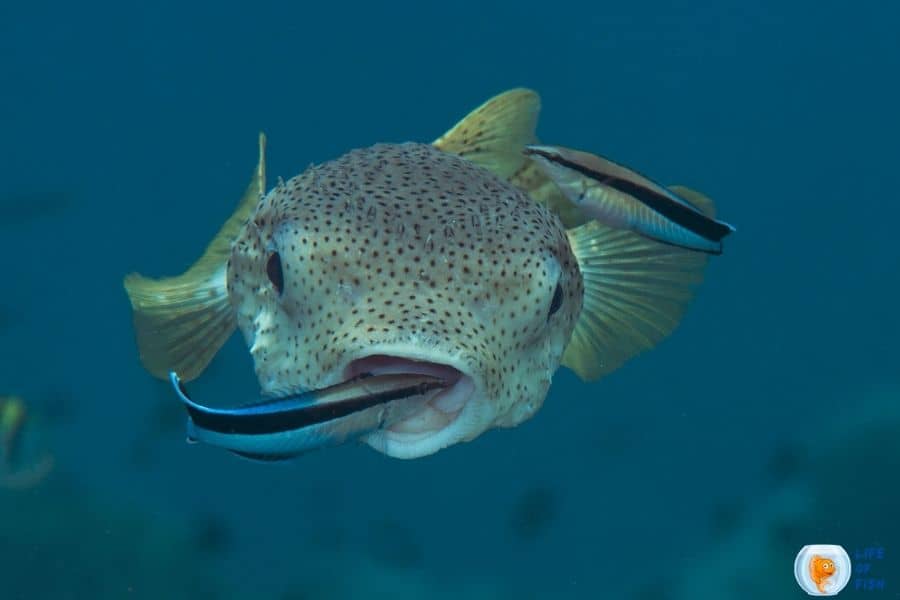
How big do they get?
Bluestack cleaner wrasse is a small fish species that can grow up to 14cm. However, their average size is 10cm.
Are they aggressive?
Bluestack cleaner wrasse is not an aggressive fish, but it will eat almost all the other small creatures approaching its cleaning station. So, it is better to keep them with large fish species.
Their behavior
Bluestack cleaner wrasse will spend most of its time picking parasites and dead skin from other fish. They usually stay hidden in a specific spot waiting for other fishe to come to them.
Cleaner wrasses have a symbiotic relationship with other fish species where they provide them with cleaning services and get food from them. They fearlessly go into the mouths and gills of larger fish, following smaller fish, which approach them to get parasites removed. Cleaner wrasses can also be seen cleaning themselves while hiding in a hole or while resting.
These fish usually form a pair or a group of juveniles or females with one male and construct a “cleaning station” to get food in the wild.
Here they eat parasites, dead skin, or damaged tissue of the host fish while hiding in a hole, on a coral branch, or under a ledge. However, in captivity, these fish tend to live in pairs. If kept in solitary, cleaner wrasse will not form a cleaning station, and they will not be able to do their job.
How long do Bluestreak cleaner wrasses live?
These fish can live up to 4 years in captivity if adequately cared for, though they tend to live much longer in the wild.
One Look Care Guide
| Scientific name | Labroides dimidiatus |
| Common name | Bluestreak cleaner wrasse |
| Care level | Difficult to Impossible |
| Native to | The Indian Ocean and Western Pacific Ocean |
| Type | Saltwater fish |
| Color | Black stripe on white body |
| Tank size | 100 gallons minimum |
| Preferred temperature | 72-78°F |
| Other water parameters (ammonia, etc.) | pH level: 8.1-8.4 Hardness: dKH 8-12 Salinity: 1.020 – 1.025sg |
| Preferred salinity | 1.020 – 1.025 |
| Size | Maximum 14 cm, average 10 cm |
| Life span | Four years |
| Temperament | Peaceful |
| Recommended tank mates | Any peaceful fish except large aggressive and semi-aggressive fish |
| Preferred food | Parasites and other debris on other fish Cyclopeeze Daphnia Finely chopped meat-based food such as Shrimp Squid Clams Beef heart |
| Feeding frequency | Several times per day |
| Breeding | Not successful in captivity, egg layers |
Bluestreak cleaner wrasse care
Bluestack cleaner wrasse is a very difficult fish to care for in captivity. Experts recommend not trying to keep these fish in home aquaria unless you have advanced-level knowledge.
These fish are the best surviving species out of all the Labroides species. Still, they are known to last only about a couple of weeks to a month in captivity. This will happen even if they feed properly with a varied diet.
If you are not an expert aquarist, you possibly can not provide all the nutrition they need because of their special diets.
Bluestack cleaner wrasse is considered one of the most difficult fish species to care for, and even experts can’t be sure about their success. If you wish to take up the challenge of keeping these fish, here are some actions you can take to increase your chances of success.
tank size
Even though this is a small fish species, they require ample space to thrive in captivity. This is because these fish need some other large fish species at their “cleaning station.” In an aquarium, it is common for these fish to host a cleaning station in the open areas of your tank. So, a minimum tank size of 100 gallons is needed for one or two fish.
How many of them should be kept together?
Interestingly, you can keep only one fish, a pair, or a group of fish together in your aquarium.
Although these fish live together in a group known as a school in the wild, there is no guarantee that these fish will do so in your aquarium. In captivity, they tend to form pairs, so it is essential to add different-sized wrasses as it is difficult to tell the sexes of these fish. But remember, you should increase the tank size accordingly if you keep a group of these fish.
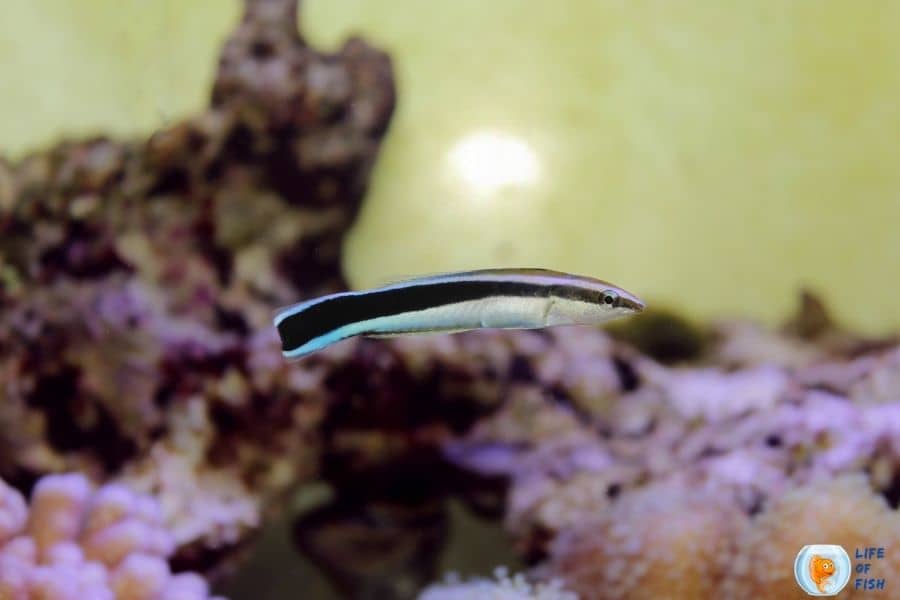
Tank setup
Since these fish are reef fish, you need to provide a reef aquarium for them to thrive. The tank should have reefs as well as rocks and other hiding spots for these fish to feel safe.
- Substrate
The environment around reefs contains a sandy substrate, so it is essential to include a sandy substrate in your aquarium. Further, these fish often burrow in the sand at night to sleep. You can have a deep sand bed or choose a shallow one depending on the type of reef you want to create.
- Decorations
These wrasses require plenty of live rocks for hiding and establishing their “cleaning station.” However, if you keep only one wrasse in the aquarium, it will not “clean” other fishes, which may cause malnutrition over time. Other hiding spots like caves and rocks are not required but don’t harm them if you add them to your aquarium.
- Filtration
Reverse flow filtration is required for keeping these fish because it helps reduce the risk of mortality.
- Lighting
They are reef fish requiring moderate to high lighting.
- Tank lid
You must cover your tank with a tank lid because these fish tend to jump out of the tank. If you want to keep these fish in your aquarium, other maintenance requirements include regular water changes, substrate vacuuming, and cleaning the rocks at least once a week.
Water quality condition
They require a maximum water temperature of 78°F, a minimum temperature of 72°F, and a pH of 8.1 to 8.4. The ideal water hardness is about dKH 8-12, and the salinity is between 1.020 sg and 1.025sg.
These water conditions mimic the natural habitats of these fish, which are coral seas around the Indian Ocean. As these are susceptible fish, you must be very careful when controlling the water conditions. One wise decision is to use smart aquarium equipment like an “auto dosing pump” and an “auto water condition checker” so that you can easily and accurately maintain the water conditions of your aquarium.
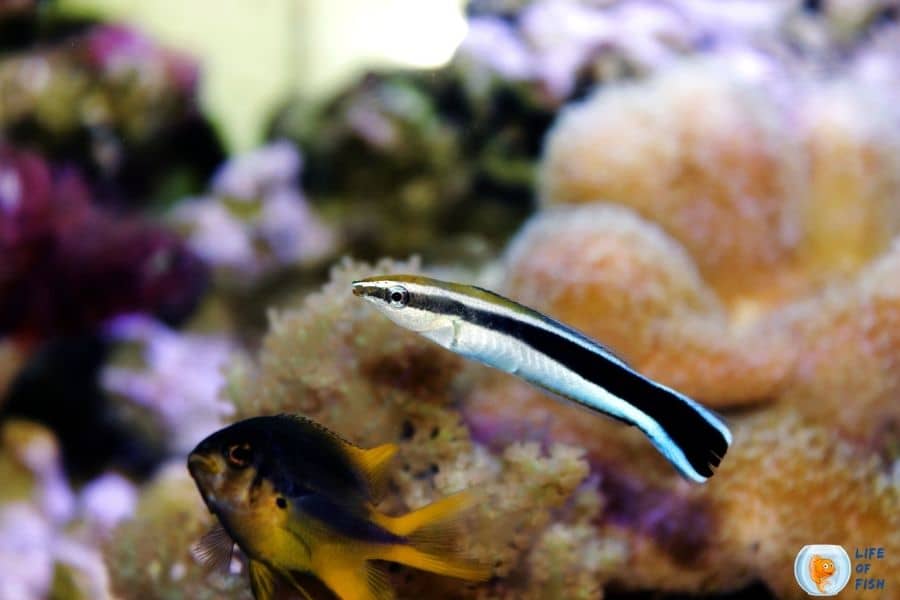
Bluestreak cleaner wrasse breeding
Bluestack cleaner wrasse is reported to spawn in aquarium settings but, the eggs don’t surpass the larval stage. Further, the fry of these fish tends to be eaten by other fish in the aquarium. You must keep more than one fish for them to spawn in the aquarium. However, most aquarists will find it difficult as their mortality rate increases in captivity.
Still, if the fish survives and acclimate well to your aquarium, you can observe a fascinating courtship ritual. The pair will start chasing each other, which involves a lot of “head butting” between them.
When spawning, the female will release the eggs into the water column, and the male will fertilize them. However, the eggs do not hatch or get eaten by other fish. These fish spawn once per day during the twilight hours, so it is common for the owners to miss the dance.
male or female identification
They do not show sexual dimorphism. So, it is impossible to differentiate males from females. However, these fish are hermaphroditic. So, they can change their sex when there is no male specimen in the “harem.”Bluestreak cleaner wrasse usually forms a “harem” in a group with several females to one male.
So, sexing shouldn’t be a problem if you introduce young specimens to your tank. If there are no males in the group, the dominant female will transform into a male.
Identify pregnant Bluestreak cleaner wrasse
Since it is impossible to identify the female specimen, it is not possible to identify the pregnant fish. However, if the fish is kept in perfect water conditions, it can spawn within a few weeks of capture. They are reported to spawn about once per day, and they are egg-laying fish.
Special tips
They have a better survival rate when kept in a tank with lots of large fish. This way, these fish have enough supply of food. If the budget allows it, always go for smart aquarium equipment to control the water conditions.
These fish are usually shy to start with. However, give them enough time to get comfortable in your aquarium. They can be trained to take food from you, and after a few weeks, they can become very calm. If these fish are out of food, they will accept some flake food or other dried food.
How to feed Bluestreak cleaner wrasse?
They are carnivore fish and feed on parasites and dead tissue from the body of bigger fish. They usually get their food from the hosts that visit them in the aquarium. However, when no fish is available in the tank, they will accept dried and frozen foods. However, this is not recommended because these fish will eventually die because of malnutrition.
They are obligatory feeders that require “cleaning” of other fish to get all the nutrition they need. They consume parasites, mucus, dead tissues, and other debris from all parts of other fish’s bodies, including mouths, gills, and fins. These fish require ALL of this food to get all the nutrition they need.
If you have a bigger tank that contains larger fish, it is easy to maintain them. However, these fish are not suitable for small tanks as they require lots of space with large fish to eat from. You can, however, supplement the feedings with Cyclopeeze, daphnia, or finely chopped meat-based food such as shrimp, brine shrimp, squid, and clams.
Many aquarists have had success with the finely chopped beef heart as well. In the wild, these fish do their cleaning job all day long, so they are used to eating several times per day. As they do not have access to much food in an aquarium setting, you need to feed them several times per day.
As you see, getting these fish to eat well is a challenge as they demand large amounts of food. Even with these efforts, these fish have a questionable survival rate. But, if you know what you are doing, you can have a happy cleaner wrasse in your aquarium.
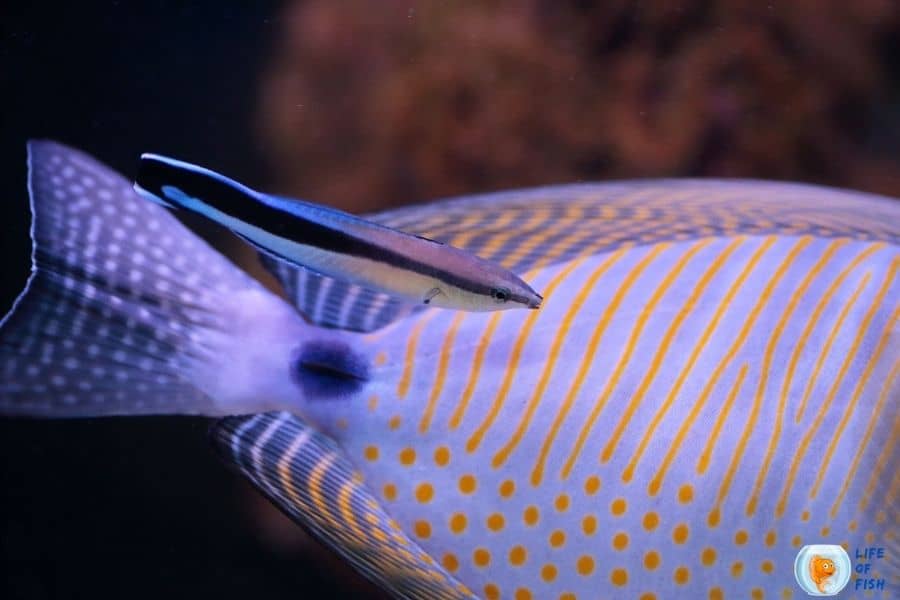
What fish can live with Bluestreak cleaner wrasse?
Even though most fish benefit from Bluestreak cleaner wrasse, some fish see them as prey and try to eat them. Especially, large predatory fish like lionfish, groupers, and soapfish may predate on these fish. So, if you house them with Bluestreak cleaner wrasses, you will have to monitor the tank closely.
The same is true for large, semi-aggressive fish as well. Although most fish will admire cleaner wrasses services, some fish species like large morays, anglers, and frogfish won’t like it and will attempt to eat them. While this won’t happen with all of your fish, you can actually house semi-aggressive fish with Bluestreak cleaner wrasses. However, close monitoring is necessary for the safety of your wrasses.
Other than large aggressive and semi-aggressive fish, almost all the fish species will admire the presence of Bluestreak cleaner wrasses.
Some compatible fish species are,
- Gobies
- Dartfish
- Assessors
- Fairy wrasses
- Anthias
- Clownfish
- Dwarf angels
- Dottybacks
- 6-line wrasse
- 8-line wrasse
- Damselfish
- Seahorses
- Pipefish
- Mandarins
The list is quite long. However, you should research your fish species before including them in the same tank as they can be aggressive or poisonous. Further, these fish can safely cohabit with corals, live rocks, anemones, shrimp, crayfish, crabs, and other large invertebrates.
Related questions
Are Bluestreak cleaner wrasses rare?
They are not rare and abundant in their natural habitats. However, they are rare in the aquarium trade because of their difficulty caring in captivity. However, these fish are not overpriced either. They are relatively cheap and affordable, but they are hard to maintain.
How long does a Bluestreak cleaner wrasse live?
They have an average life span of 4 years. However, many specimens don’t live that long in captivity and have a very short life span. Most cleaner wrasses live only about two weeks to a month in captivity. But, if you are an expert, you can give them a longer life by setting up a proper environment for these fish.
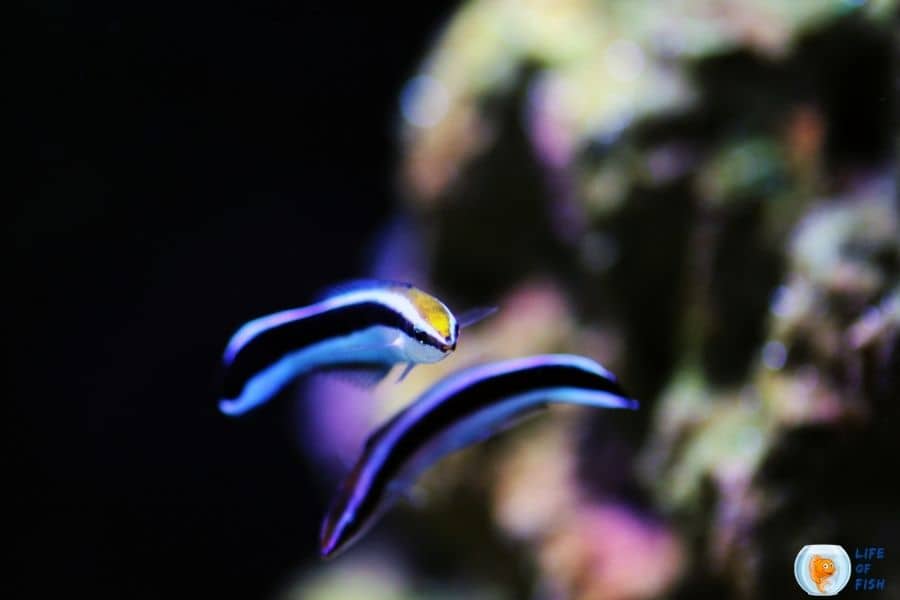
What do Bluestreak cleaner wrasse clean?
They are a beneficial partner to larger fish. They clean off parasites, ich, and other harmful things from the skin of bigger fish. This partnership has been going on for a long, and it is crucial for the survival of both parties.
These fish clean off parasites or ich from your resident fish in an aquarium setting. Some may even pick up objects that you place in the tank-like shells, rocks, and other items. You can even put live rock or corals in the tank to have these fish clean them off. In fact, these fish will be beneficial in keeping the tank clean and healthy.
Are cleaner wrasses immune to ICH?
No. Cleaner wrasses are just like any other fish. They also are not immune to marine Ich (Cryptocaryon irritans). They even do not pick these parasites from other fish while cleaning. These fish are helpless against marine ich and can get infected.
So, if you notice any of the cleaner wrasses showing signs of this parasite (black spots and white lumps), immediately remove him from the tank and treat the whole tank with copper. If it is not enough, you can use an antibiotic like penicillin to kill the parasite. But, you should monitor your cleaner wrasses closely after medicating because many fish are not immune to this antibiotic.
Do cleaner wrasses eat copepods?
Yes. Cleaner wrasses are carnivore fish species. They clean the fish by eating off their parasites. But, they also eat shrimps, small crustaceans, and other invertebrates that live on their client fish. This includes copepods.
Conclusion
Bluestreak cleaner wrasse is a beautiful fish that can color up your aquarium. But, they are expert-only fish that need special care. For Bluestreak cleaner wrasses to be happy and healthy, you should set up a proper environment for them. Use your research before getting yourself one of these wonderful creatures.
Read Next : Ballan Wrasse | More About Beautiful And Unpopular Fish | Cuckoo Wrasse ( Their Color Is Out Of This World )
